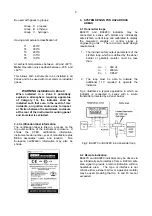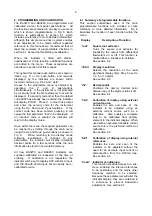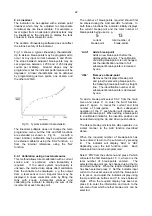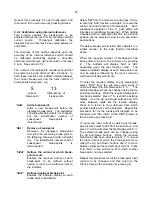
9
6. PROGRAMMING AND CALIBRATION
The BA327C and BA328C are programmed and
calibrated via four front panel push-buttons. All
the functions are contained in an easy to use menu
which is shown diagramatically in Fig 6. Each
function is summarised in section 6.1 which
includes a reference to more detailed information.
Although this simple menu driven system enables
most adjustments to be made without repeated
reference to this manual, we recommend that at
least the summary of programmable functions in
section 6.1 be read before starting recalibration.
When the indicator is fitted with alarms,
linearisation or a tare function, additional functions
are added to the menu. These accessories are
described in section 9 of this manual.
Throughout this manual push-buttons are shown in
italics e.g. P or Up push-button, and legends
displayed by the indicator are shown within
inverted commas e.g. 'CAL' and ' ALr2'.
Access to the programme menu is obtained by
operating the P and E push-buttons
simultaneously. If the instrument is not protected
by a security code the first parameter 'root' will be
displayed. If a security code other than the default
code 0000 has already been entered, the indicator
will display 'COdE'. Press P to clear this prompt
and enter the security code for the instrument
using the Up, Down and P push-buttons. If the
correct code has been entered pressing E will
cause the first parameter 'root' to be displayed. If
an incorrect code is entered the indicator will
return to the display mode.
Once within the menu the required parameter can
be reached by scrolling through the main menu
using the Up and Down push-buttons as shown in
Fig 6. When returning to the display mode
following recalibration or changes to any
parameters, the indicator will display circulating
decimal points for a few seconds while the new
information is stored in non-volatile memory.
All new BA327C and BA328C indicators are
supplied calibrated as requested at the time of
ordering. If calibration is not requested, the
indicator will be set to display 0.00 with 4mA input,
and 100.00 with 20mA input, but can easily be re-
calibrated on-site.
6.1 Summary of programmable functions
This section summarises each of the main
programmable functions and includes a cross
reference to more detailed information. Fig 6
illustrates the location of each function within the
menu.
Display
Description of function
'root'
Square root extractor
Turns the square root extractor for
linearising the output from differential
flowmeters on or off. This function is
omitted when a lineariser is installed.
See section 6.2
'rESn'
Display resolution
Selects the resolution of the least
significant display digit. May be set to
1, 2, 5 or 10 digits.
See section 6.3
'd.P.'
Decimal point
Positions the dummy decimal point
between any of the digits or turns it off.
See section 6.4
'CAL'
Calibration of display using external
current source.
Enables the zero and span of the
indicator to be adjusted using an
external current source such as a
calibrator. Also enables a complete
loop to be calibrated from primary
element to the indicator display. When
used with an accurate traceable current
source this is the preferred method of
calibration.
See section 6.5
'SEt'
Calibration of display using internal
references.
Enables the zero and span of the
indicator to be adjusted without the
need for an accurate input current or
disconnection from the 4/20mA loop.
See section 6.6
'Cond'
Indicator conditioning
This function provides access to a sub-
menu enabling the internal references
to be calibrated, and the mains (line)
frequency rejection to be selected.
Because these parameters will alter the
indicator display, they are contained in
a sub-menu to prevent inadvertent
adjustment. See section 6.7










































